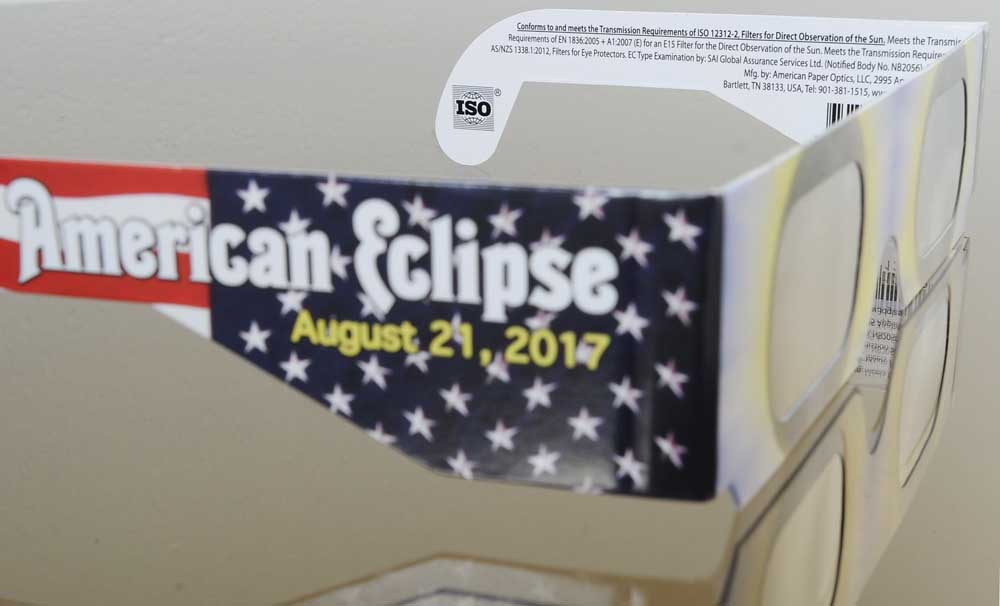No. 1 eclipse tip: Protect your eyes
Published 8:58 am Monday, August 21, 2017

- Glasses for safely viewing the upcoming solar eclipse should have the ISO number 12312-2 and the manufacture's name and address printed on them. (Ryan Brennecke/Bulletin photo)
If there’s only one thing you remember about the solar eclipse coming Aug. 21, it should be this: Protect your eyes.
Preparation has stepped up in recent months as law enforcement, emergency responders, hospitals, business owners and others brace for the total eclipse of the sun and the roughly 1 million visitors the event is expected to bring to Oregon. That’s led health experts and public officials to stress safety so eclipse viewers don’t permanently damage their eyes.
To view the eclipse directly, you need either special glasses or a handheld filter. And, according to NASA, they’re not all created equal. NASA has offered a checklist to make sure glasses are up to snuff.
Eclipse viewing glasses and handheld solar viewers should:
• Have an “ISO” icon and reference the 12312-2 international standard.
• List the manufacturer’s name and address somewhere on the product.
NASA says not to use glasses that are older than three years, or have scratched or wrinkled lenses. And people watching the eclipse should not use homemade filters or regular sunglasses, even seemingly dark ones, because they are not safe for looking directly at the sun.
The solar filters in eclipse glasses or handheld viewers are about 100,000 times darker than ordinary sunglasses, according to the American Astronomical Society.
The society has verified five manufacturers that are making eclipse glasses and handheld viewers that meet the ISO 12312-2 international standard: American Paper Optics, Baader Planetarium (AstroSolar Silver/Gold film only), Rainbow Symphony, Thousand Oaks Optical and TSE 17.
Eclipse glasses that generally cost a few dollars a pair are a small price to pay to avoid permanently hurting your eyes.
Brandon Lujan, an ophthalmologist and assistant professor at Oregon Health & Science University’s Casey Eye Institute, said looking at the sun during the eclipse is no different than looking at the sun in general, unless you’re in the path of totality. That 70-mile-wide path stretches from Oregon to South Carolina and includes a few cities in Central Oregon. In Madras, Warm Springs, Sisters, Redmond and Prineville the moon will completely cover the sun for varying times between areas. Bend will have more than 99 percent coverage, according to NASA’s solar eclipse map.
Even in the path of totality though, it’s only safe to look at the eclipse for the moment the moon covers the sun completely. Before and after that, viewers should be using the special glasses or viewers verified by AAS, according to Lujan. Viewers can also use welder’s glasses with a #14 or darker filter, according to Lujan. NASA warns arc welders generally use glass with a lighter shade, so viewers shouldn’t use welder’s glasses if they can’t verify the shade number. Indirect viewing techniques, such as pinhole projection, where a person looks away from the sun and projects the eclipse’s shadow onto the ground or a piece of paper, are also safe, Lujan said. NASA describes ways to safely use pinhole projection on its website.
“During the eclipse, it’s less bright, but the UV rays are still getting through,” Lujan said. “Those rays, just like the visible rays, get focused on the eye in the retina in the back of the eye.”
The retina is like film in a camera, Lujan said. When a person looks into the sun, its rays set off a chain of reactions that damage the retina.
“The last time there was a (total eclipse viewable in Oregon), there were a number of reports and papers that got published about people coming in with damaged eyes,” Lujan said. That was in the late ’70s.
People weren’t coming in to get their eyes checked in droves, Lujan said, but there were definitely people affected. Lujan and his colleagues expect that will be the case again, although they and others have been working to get the word out to wear protective glasses.
There is no treatment for people who damage their eyes by looking at the sun. The damage the sun causes to retinas is delayed because it’s a chemical reaction, so on average it will take a person six to 12 hours to notice a change in vision. And the eye won’t look physically different on the outside — an ophthalmologist or optometrist needs to diagnose it.
Retinas should be transparent; one damaged by the sun will have a whitish spot that will become darker in pigment, Lujan said. The damage generally improves over time, but it can still block a person’s vision.
Lujan hasn’t personally seen a patient’s eyes damaged by the sun, and he hopes the eclipse next month doesn’t change that.
“I’ll be happy to retire without having seen it,” Lujan said.
While it may soon be cutting it close to order eclipse glasses online (some manufacturers recommend ordering by Aug. 1) and other online retailers are already sold out completely, a number of places around Central Oregon are selling them, from grocery to home improvement stores to gas stations. At Newport Avenue Market in northwest Bend, where the glasses are going for $1.49 a piece, the store has had to restock its supply several times over the past few months.
“We underestimated how quickly they’d sell,” said Erika Maloley, floral manager and gift buyer at Newport Avenue Market. “We’ve done probably three or four reorders.”
So far, Newport has ordered more than 5,000 pairs, and has gone through most of those. Maloley said the market still has plenty in stock now, but she expects she’ll do one more order. Newport’s glasses are made by American Paper Optics, one of the manufacturers verified by AAS.
— Reporter: 541-383-0325, kfisicaro@bendbulletin.com






